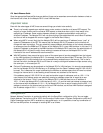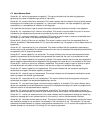Event Histories F-5
Cause No. 83: a suspended call exists, but this call identify does not. This cause indicates that a call
resume has been attempted with a call identity which differs from that in use for any presently suspended
call(s).
Cause No. 84: call identity in use. This cause indicates that the network has received a call suspend request.
The call suspend request contained a call identity (including the null call identity) which is already in use for a
suspended call within the domain of interfaces over which the call might be resumed.
Cause No. 85: no call suspended. This call indicates that the network has received a call resume request.
The call resume request contained a call identity information element that presently does not indicate any
suspended call within the domain interfaces over which calls may be resumed.
Cause No. 86: call having the requested call identity has been cleared. This cause indicates that the network
has received a call resume request. The call resume request contained a call identity information element that
once indicated a suspended call; however, that suspended call was cleared while suspended (either by network
timeout or by remote user).
Cause No. 88: incompatible destination. This cause indicates that the equipment sending this cause has
received a request to establish a call that has a low layer compatibility, high layer compatibility, or other
compatibility attributes (e.g., data rate) that cannot be accommodated.
Cause No. 91: invalid transit network selection. This cause indicates that a transit network identification of
an incorrect format as defined in Annex C/Q.931 was received.
Cause No. 95: invalid message, unspecified. This cause is used to report an invalid message event only when
no other cause in the invalid message class applies.
Cause No. 96: mandatory information element is missing. This cause indicates that the equipment sending
this cause has received a message that is missing an information element that must be present in the
message before that message can be processed.
Cause No. 97: message type non-existent or not implemented. This cause indicates that the equipment
sending this cause has received a message with a message type it does not recognize either because this is a
message not defined or defined but not implemented by the equipment sending this cause.
Cause No. 98: message not compatible with call state or message type non-existent or not implemented.
This cause indicates that the equipment sending this cause has received a message such that the procedures
do not indicate that this is a permissible message to receive while in the call state, or a STATUS message was
received indicating an incompatible call state.
Cause No. 99: information element non-existent or not implemented. This cause indicates that the
equipment sending this cause has received a message that includes information elements not recognized
because the information element identifier is not defined or it is defined but not implemented by the equipment
sending the cause. However, the information element is not required to be present in the message in order for
the equipment sending the cause to process the message.
Cause No. 100: invalid information element contents. This cause indicates that the equipment sending this
cause has received an information element which it has implemented; however, one or more of the fields in the
information element are coded in a way that has not been implemented by the equipment sending this cause.
Cause No 101: message not compatible with call state. This cause indicates that a message has been
received that is incompatible with the call state.
Cause No. 102: recovery on timer expiry. This cause indicates that a procedure has been initiated by the
expiry of a timer in association with Q.931 error handling procedures.


















